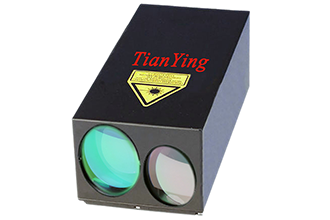China TianYing TY-LR71 mini 1540nm 7km eye safe laser rangefinder of 1 Hz continuous for 10m² airplane, designed for integration into compact airborne, maritime and land based optronic systems, provides accurate and effective range performance to dynamic targets in extremely compact unit that weighs only 100 g.
Depending on weather conditions and target characteristics, ranges between 30 m and 13 km can be measured, beyond 10.8km building 2Hz has been proven in 15km visibility. The measuring accuracy is less than 1m.
The model has reached the domestic leading and world advanced level,the price can compete with Europe and North America manufacturers. With its performance, this LRF give you highest performance price rate.
5km~7km 1540nm Wavelength Laser Rangefinder Features:
1. Outstanding signal processing capabilities.
2. Smallest size.
3. Lightest weight.
4. Highest reliability life.
5. Lowest consumption.
6. Highest performance price rate.
5km~7km 1540nm Wavelength Laser Rangefinder of Application:
1) Gimbals.
2) Fire control systems.
3) Remote weapon stations.
4) Observation and surveillance systems.
5) Coastguard and border protection.
6) Handheld targeting systems.
5km~7km 1540nm Laser Rangefinder Mainly Specification:
| Model |
TY-LR71 |
| Transmitter |
| Laser Type |
Erbium-glass Diode Pumped |
| Wavelength |
1540nm |
| Measuring rate(programmable) |
1Hz for full range performance. |
| |
5Hz work 1min and rest 30secs for approx. 80 % of full range performance |
| Beam divergence |
≤ 0.5 mrad, typical 0.3mrad. |
| Laser classification |
Class 1. |
| Receiver |
| Detector |
Avalanche Photo Diode Detector (APD). |
| Range data |
| Ranging capability |
≥ 10km (even 13km) for building/house in 23.5km visibility. |
| |
≥ 6km of 30% albedo 5m² aircraft in 23.5 km visibility. |
| Accuracy |
≤ +/-1m |
| Electrical interface |
| Data interface |
RS422 |
| Power |
12V DC |
| Environmental conditions |
| Operation Temperature |
-40ºC~+60ºC |
| Reliability |
| Life |
≥ five hundred thousand range measurements (shot lifetime ≥ five million) |
| Mechanical interface |
| Size |
≤ 120 cubic centimeters |
| Weight |
100g |
| * - Note |
*Product design and Technical information is subject to change without notice.
** Depending on the region of sale. |
Question:
1, Why many 20km/30km/40km laser rangefinder can not measure tank 10km in standard 23.5km visibility?
Because their 20km/30km/40km is theory data or high reflection large target in ideal visibility condition, even reflection need beyond 80% and visibility need beyond 50km.
2, Why many NATO target 10% reflection 12km laser rangefinder can not measure tank 10km in standard 23.5km visibility?
Because their 10% reflection is not real performance data, 2.3m x 2.3m NATO target is not real tank, or their NATO target effective size is different; normal 2.3m x 2.3m target real albedo is 50% or more.
About test land standard, normal big target typical 20km LRF with 25km visibility, then, normal this LRF can measure 2.3m x 2.3 target about 15km or more, then, 30% albedo 2.3m x 2.3m target is about 10km ~ 12km.
Also, starting state and stable state measuring range is different too, such as 15mJ-25mJ LRF, starting state is 25mJ, typical stable state is only 15mJ, only many companies are only said starting state, for example, said single pulse laser energy is at least 25mJ.
3, Why many laser rangefinder do not show measurement rate details?
Because max rate and continuous rate technology demand is different, such as max 12.5Hz 10 sec to 60 sec, maybe then 5Hz is max 1 min to 3 min with cycle.
Also, when rate have more different, such as 1Hz-5Hz, 1Hz-10Hz, 1Hz-20Hz, 5Hz-25Hz etc, then their working distance have more different too.
About 1.5µm eye safe laser rangefinder, if 1Hz is 10km, then, normal 5Hz is only balance about 80%~ 85%, normal 10Hz is only balance about 70%~80%, when this LRF laser energy is very low, then attenuation speed will accelerate.
4, Why normal mid-long range high rate laser rangefinder do not use for Erbium-glass laser?
Because normal Erbium-glass laser energy is too low, high rate continuous measuring time is too short, especially at extreme operating temperatures.
In fact, if Erbium-glass laser want to meet demand, energy need at least 2mJ, normal need 5mJ to 8mJ.
Then, Erbium-glass is not competitive with OPO and Raman shifted.
5, Why many laser rangefinder price is very cheap?
Because performance is different, for example: one LRF is used for bad cable, messy interface, messy wiring etc, then the LRF cost can reduce, even reduce much, but no warranty on performance.
If used for same performance, then our price is very cheap. that is why many laser rangefinder do not show their real main performance data.

